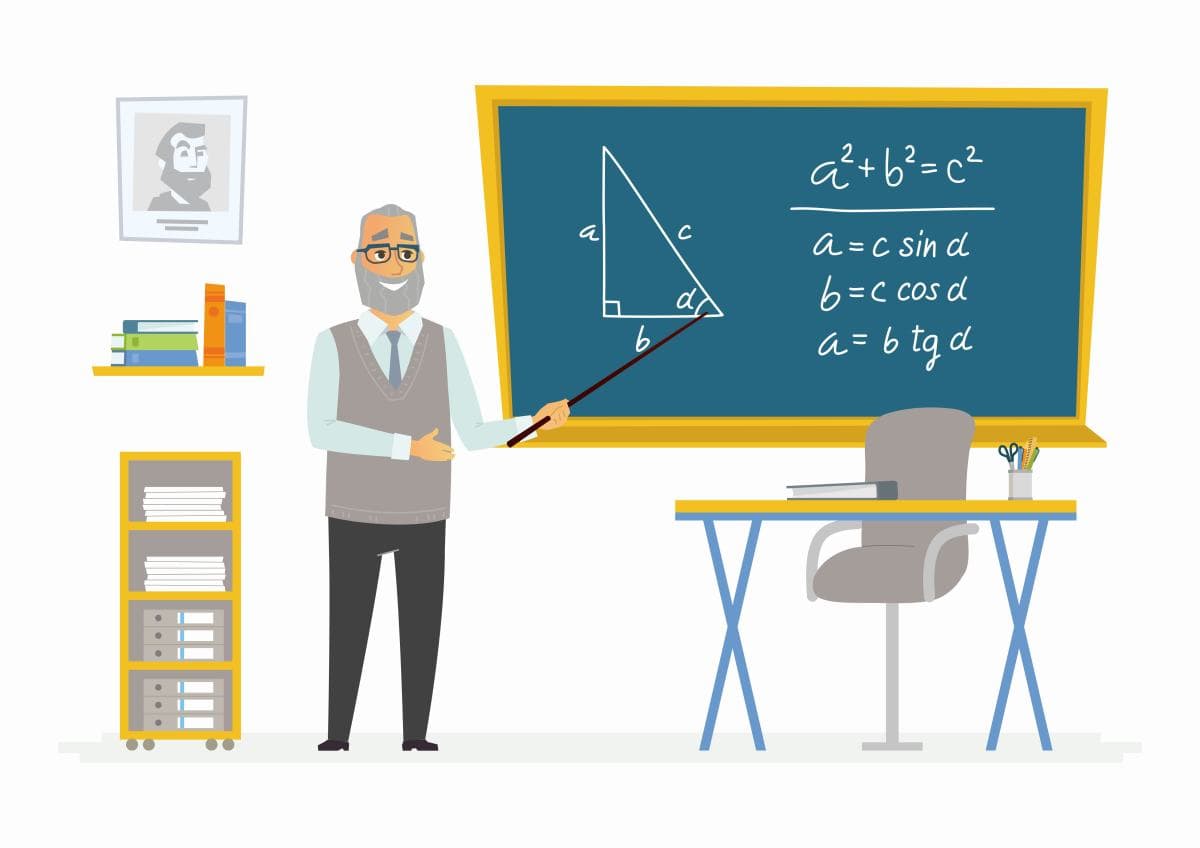
The ACT Math is the second section of the exam, coming right after the English portion. It’s a section containing 60 questions, with a time limit of 60 minutes.
The length of ACT Math is what most students consider to be one of the most challenging parts of the section. To make things even more complex, ACT Math is purely content-based — you’d need to have a solid understanding of topics like proportional relationships, the Pythagorean Theorem, trigonometry, and other fundamental math concepts.
So what then is ACT Math section mainly made of? What else can you expect from this section, and what can you do to get a high score? We created a helpful guide on everything you need to know about ACT Math — and how to make sure you don’t get lost in the numbers.
Remember all those classes on algebra, trigonometry, geometry, and advanced math you’ve taken throughout high school? The concepts under these subjects are actually what the ACT Math would cover. The ACT puts emphasis on lessons learned under Algebra 1 and 2; taking the ACT without completing these prerequisites would make it more challenging for you.
However, the ACT Math is not the typical math tests you were given in the classroom. It will involve a lot more reasoning and problem solving — basically measuring your knowledge of foundational math concepts using a more practical approach.
ACT Math questions are arranged in an order where you’ll answer the least difficult ones first, gradually increasing difficulty until you get to the hardest ones.
That said, questions 1–20 are considered low-difficulty; 21–40 are medium-difficulty; and 41–60 are high-difficulty. While the questions are arranged in such order, the topics tested will appear in any order, meaning concepts won’t necessarily be grouped together throughout the exam.
Of course, this is only an estimation; the difficulty of the questions may be relative to the student answering them.
Since you’d basically need to answer each question in 1 minute max, it’s crucial to know what formulas to memorize and familiarize yourself with. This is so you don’t spend too much time racking your brain for the correct one while answering the test.
Here are some of the commonly used formulas in ACT math (plus how to use them and what they mean):
For Algebra, you’d have to memorize formulas used for solving linear equations such as the slope, slope-intercept form, and midpoint formula.
Slope
Slope is the measure of how a line changes. It’s typically expressed as the rise over run formula, and given that there are two points namely A(x₁,y₁), B(x₂,y₂), you can find the slope of the line that connects them by using (y₂−y₁)/(x₂−x₁).
Slope-intercept form
A linear equation is interpreted as y = mx + b.
Mean = Sum of the terms / the number of terms
Speed = total distance / total time
Probability of an outcome happening = number of desired outcomes / total number of possible outcomes
Outcome of multiple probabilities = probability 1 * probability 2 for as many probabilities as there are
Example: Event A has a probability of ⅓ and Event B has a probability of ⅙. The probability of both events happening is (⅓) (⅙) = 1/18. This means that there is a 1 in 18 chance of both events A and B happening.
Possible combinations = (No. of element A) (No. of element B) (No. of element C)
In the ACT, you might encounter at least one question about logarithms. Fortunately, you don’t have to memorize a lot of formulas for this — you just need to know how to rewrite logs. You can do this using the following formula:
logb(x)= y → by= x
logb(xy) = logbx + logby
logb(x/y) = logbx − logby

Here are the formulas to remember for both plane and solid geometry:

Rectangle
l is the length of the rectangle; w is the width; and h is the height.
Area = lw
Perimeter = 2l + 2w
Volume = lwh

Square
a is the length of the sides of the square
Area = a²
Perimeter = 4a

Parallelogram
l is the length of the parallelogram; and h is the height.
Area = lh
The parallelogram’s height will be equivalent to a rectangle’s width, as you’d need to drop down two right angles to make it into a rectangle.

Triangle
b is the length of the triangle’s base; and h is the height.
Area = ½bh

Right triangle + Pythagorean Theorem
a² + b² = c²
For right triangles, the two smaller sides (a and b) are squared. Their sum would be equal to the square of the triangle’s longest side, or the hypotenuse.
Isosceles Triangle
Side lengths = x, x, x√2
Isosceles triangles are, by definition, a triangle with at least two sides of equal length (x).

Trapezoid
b is the length of the trapezoid’s base; and h is the height.
Area = ½(b₁ + b₂)h

Circle
r is the radius of the circle (a line drawn from the center point going to the edge of the circle); and 𝝅 is a constant that’s written as 3.14159, or simply 3.14.
Area = 𝝅r²
d is the diameter of the circle. It is equivalent to twice the radius, being the line that extends from the midpoint going to two ends of the circle on opposite sides.
Circumference = 2𝝅r or 𝝅d

Cylinder
r is the radius of the cylinder (a line drawn from the center point going to the edge of the circle on the circular sides); h is the height of the cylinder; and 𝝅 is a constant that’s written as 3.14159, or simply 3.14.
Volume = 𝝅r²h
Key elements to remember:
SOH, CAH, TOA
You’re most likely familiar with the sine, cosine, and tangent of an angle (written as Θ). The formulas for calculating for each of these are as as follows:
Cosecant, Secant, Cotangent
Cosecant is the reciprocal of sine, expressed as:
Cosecant 𝛩 = hypotenuse / opposite
Secant is the reciprocal of cosine, expressed as:
Secant 𝛩 = hypotenuse / adjacent
Cotangent is the reciprocal of tangent, expressed as:
Cotangent 𝛩 = adjacent / opposite
We know what you’re thinking: that all of these are overwhelming. The good news is that not all of the questions will warrant the use of a formula and a calculator. There will be questions that would test your skills on other math concepts, such as the FOIL method, reasoning, and exponential rules. However, we strongly advise memorizing these formulas as you study — you won’t be allowed to use a formula cheat sheet during the exam.

You now know what general math topics are covered in the ACT; now, let’s take a look at the specific subtopics where the questions will be based on.
1. Pre-Algebra
2. Elementary Algebra
3. Intermediate Algebra
4. Coordinate Geometry
5. Plane Geometry
6. Trigonometry
7. Functions
8. Integrating essential skills
Feeling pressured just yet? Relax, ACT’s math section doesn’t have to be daunting. Here are some strategies to help you achieve a high ACT Math score:
Focus on the easier questions first. While you may be tempted to race through the least difficult questions first to have more time for the harder ones, be sure that you give the easier questions an equal weight as the difficult ones. Remember, each question is worth the same number of points — make the most out of that 1 minute per question!
Concrete values may be easier to digest than abstract ones. If you find it hard to figure out abstract values, it may be helpful to replace them with real numbers instead. In the ACT, questions may contain statements like “find value of x” — what you could do is replace x with your chosen number and try fitting that number into the choices presented for easier visualization.
Focus on the meat of word problems. ACT math word problems may be tricky because of how they are often phrased. A technique is to focus on the math — separate the actual problem from all the complicated wording.
Know your math content. As we’ve mentioned earlier, ACT Math will primarily measure your knowledge of foundational math concepts. This said, we recommend brushing up on your conceptual math skills and practicing on any topic you haven’t had an opportunity to apply in a while. Learning techniques like using flash cards will help you quickly memorize those formulas, and using a test prep course that utilizes spaced repetition will also work wonders for retention.
So that’s everything you need to know about ACT Math! We hope this guide helps you prepare not only for this specific section, but for the ACT as a whole. If you’re looking for additional resources, we created a great ACT course that contains everything you learned here and much more, including tons of practice questions and full-length practice sections for the ACT Math.
Feel free to browse through our other posts for other useful tips and techniques on acing the ACT!

Looking for the average ACT scores by state and the percentage of graduates that took the ACT? Then look no further! In this deep dive, we review four years of data to get insight into which states are doing the best – and worst – with the ACT exam.

In this post, we’ll be sharing with you how to find the best ACT prep classes near you.

There are a lot of factors to consider as you prepare for the ACT, like your schedule, familiarization with ACT’s structure, and of course, your resources for studying. In this post, we’ll give you techniques that can help you pass (or better yet, ace) the ACT!